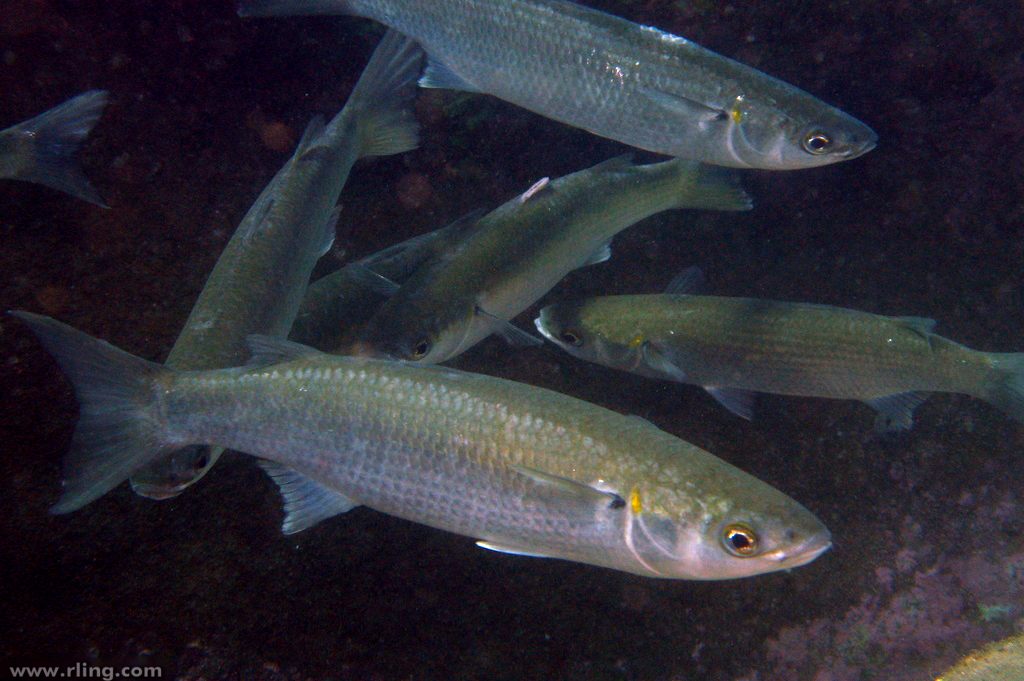- Classification
- ACTINOPTERYGII
- MUGILIFORMES
- MUGILIDAE
- Myxus
- elongatus
Sand Mullet, Myxus elongatus Günther 1861

Sand Mullet, Myxus elongatus, at Fairy Bower, Manly, New South Wales, July 2008. Source: Richard Ling / Flickr. License: CC by Attribution-NonCommercial-ShareAlike
Sand Mullet, Myxus elongatus Günther 1861
More Info
|
Distribution |
Heron Island, southern Queensland, to Mandurah, Western Australia, and northern and eastern Tasmania; also the Lord Howe Island region and Norfolk Island in the Tasman Sea. Elsewhere the species occurs in the south-west Pacific. Form schools in shallow coastal waters and lower estuaries, and juveniles may enter freshwaters. |
|
Feeding |
Feeds on small crustaceans and molluscs, and microscopic algae. |
|
Biology |
Sand mullet spawn near estuary mouths or in the sea. |
|
Fisheries |
The Sand Mullet is of minor commercial and recreational importance. |
|
Author |
Bray, D.J. 2017 |
|
Resources |
Sand Mullet, Myxus elongatus Günther 1861
References
Allan, R. 2002. Australian Fish and How to Catch Them. Sydney : New Holland Publishers (Australia) 394 pp.
Allen, G.R., Hoese, D.F., Paxton, J.R., Randall, J.E., Russell, B.C., Starck, W.A., Talbot, F.H. & Whitley, G.P. 1976. Annotated checklist of the fishes of Lord Howe Island. Records of the Australian Museum 30(15): 365-454 figs 1-2
Francis, M. 1993. Checklist of the coastal fishes of Lord Howe, Norfolk, and Kermadec Islands, southwest Pacific Ocean. Pacific Science 47(2): 136-170 figs 1-2
Francis, M.P. & Randall, J.E. 1993. Further additions to the fish faunas of Lord Howe and Norfolk Islands, southwest Pacific Ocean. Pacific Science 47(2): 118-135 figs 1-22 pls 1-4
Gill, A.C. & Reader, S.E. 1992. Fishes. pp. 90-93, 193-228 in Hutchings, P. (ed.) Reef Biology. A Survey of Elizabeth and Middleton Reefs, South Pacific. Canberra : Australian National Parks Vol. 3, Kowari 230 pp.
Gomon, M.F. 2008. Family Mugilidae. pp. 390-394 in Gomon, M.F., Bray, D.J. & Kuiter, R.H. (eds). Fishes of Australia's Southern Coast. Sydney : Reed New Holland 928 pp.
Gomon, M.F., Glover, C.J.M. & Kuiter, R.H. (eds) 1994. The Fishes of Australia's South Coast. Adelaide : State Printer 992 pp. 810 figs.
Grant, E.M. 1991. Fishes of Australia. Brisbane : EM Grant Pty Ltd 480 pp.
Günther, A. 1861. Catalogue of the Fishes in the British Museum. Catalogue of the acanthopterygian fishes in the collection of the British Museum. London : British Museum Vol. 3 586 pp.
Harrison, I.J. & Senou, H. 1999. Order Mugiliformes. pp. 2069-2790 in Carpenter, K.E. & Niem, T.H. (eds). The Living Marine Resources of the Western Central Pacific. FAO Species Identification Guide for Fisheries Purposes. Rome : FAO Vol. 4 pp. 2069-2790.
Johnson, J.W. 2010. Fishes of the Moreton Bay Marine Park and adjacent continental shelf waters, Queensland, Australia. pp. 299-353 in Davie, P.J.F. & Phillips, J.A. Proceedings of the Thirteenth International Marine Biological Workshop, The Marine Fauna and Flora of Moreton Bay. Memoirs of the Queensland Museum 54(3)
Kendall, B.W. & C.A. Gray. 2008. Reproductive biology of two co-occurring mugilids, Liza argentea and Myxus elongatus, in south-eastern Australia. Journal of Fish Biology 73: 963–97.
Kendall, B.W., Gray, C.A. & Bucher, D. 2009. Age validation and variation in growth, mortality and population structure of Liza argentea and Myxus elongatus (Mugilidae) in two temperate Australian estuaries. Journal of Fish Biology 75: 2788–2804.Kner, R. 1865. Reise des Österreichischen Fregatte Novara un die Erde in den Jahren 1857, 1858, 1859, unter den Befehlen des Commodore B. von Wüllerstand-Urbair. Zool. Theil. Fische 1 und 2. Abteilung. Wien : Kurl Gerold's & Sohn 272 pp. (as Mugil crenidens)
Kuiter, R.H. 1993. Coastal Fishes of South-eastern Australia. Bathurst : Crawford House Press 437 pp.
Kuiter, R.H. 1994. Family Mugilidae. pp. 659-664, figs 578-581 in Gomon, M.F., Glover, C.J.M. & Kuiter, R.H. (eds). The Fishes of Australia's South Coast. Adelaide : State Printer 992 pp. 810 figs.
Last, P.R., Scott, E.O.G. & Talbot, F.H. 1983. Fishes of Tasmania. Hobart : Tasmanian Fisheries Development Authority 563 pp. figs.
Marshall, T.C. 1964. Fishes of the Great Barrier Reef and Coastal Waters of Queensland. Sydney : Angus & Robertson 566 pp. 136 pls.
Ogilby, J.D. 1897. New genera and species of Australian fishes. Proceedings of the Linnean Society of New South Wales 22(1): 62-95 (as Cestraeus norfolcensis)
Prokop, F. 2002. Australian Fish Guide. Croydon South, Victoria : Australian Fishing Network 256 pp.
Thomson, J.M. 1996. Family Mugilidae. pp. 191-197 in McDowall, R.M. (ed.) Freshwater Fishes of South-eastern Australia. Sydney : Reed Books 247 pp.
Thomson, J.M. 1997. The Mugilidae of the world. Memoirs of the Queensland Museum 41(3): 457-562 fig. 1








